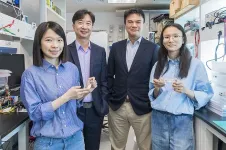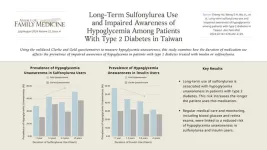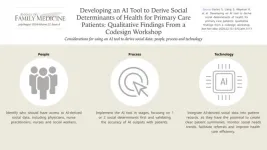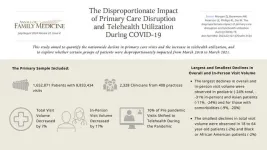Time-division multiplexing planning and design strategies for parking lots in compact cities
2024-07-23
(Press-News.org)
Compact city is an urban planning strategy aimed at promoting environmental, economic, and social sustainability through spatial configurations featured with relatively high density and mixed land use. The continuous growth in car ownership forces cities to construct more static transportation facilities such as parking lots, squeezing the activity spaces of residents and consequently giving rise to a series of efficiency and equity issues. Thus, the conflict between people and vehicles in compact cities is increasingly prominent and urgently needs to be addressed.
Time-division multiplexing (TDM), originally a term from the field of information and communication engineering, refers to the technique of transmitting multiple signals over the same communication channel in different time slots. In fact, the utilization of land resources for parking infrastructure in a TDM way has been a widespread spontaneous phenomenon to some extent. Thus, to provide references for the TDM planning and design of parking lots in compact cities, this study aims to address the following questions: How to identify urban spaces with TDM potential and determine potential demand? How to achieve it through detailed design of spaces? And, how to ensure effective implementation of the planning and design scheme with gamified public participation?
The TDM planning and design strategies for urban spaces need to comprehensively consider the usage demands of different groups at different time frames, requiring both technical expertise and practical logic. The conceptual framework proposed in this study, which was published on the journal of Landscape Architecture Frontiers and entitled “Research on Time-Division Multiplexing Planning and Design Strategies for Parking Lots under the Theory of Compact Cities”, comprises three stages of supply and demand identification, planning and design, and community engagement. The key steps include identifying idle parking spaces and potential public activity needs, designing spaces tailored to specific activity needs, and increasing public acceptance through promotion. Firstly, in the stage of supply and demand identification, utilize spatiotemporal big data such as mobile signaling to characterize changes of the overall population flow in urban spaces. Secondly, in the planning and design stage, specific planning and design are carried out for potential parking lots based on the above results. In the last stage, TDM rules formed in the design proposal will be converted into interactive models, basing on site conditions. This forms a systematic planning strategy for the TDM design of parking lots.
This study focuses on a high-density built environment in the central urban area of a city in China. The region, characterized by its long-established development, dense buildings, and high population, is part of the old central urban area, covering approximately 2.65 km² and containing 50 surface public parking lots. This has resulted in a shortage of activity space for residents in the area and strained the relationship between pedestrians and vehicles.
Through planning methods, the parking lot can function as both a parking space and an activity space in appropriate times. For safety reasons, when parking demand is low and residents’ activity demand is high, the parking space can be allocated to serve residents’ activities. Conversely, when the parking demand is high, the activity space can be reduced or even eliminated. Finally, it is vital to ensure the implementation of the TDM strategies based on the spatial characteristics of the parking lot and with the assistance of corresponding guidance facilities.
However, this study also has some limitations. Firstly, due to differences in urban parking lot management entities and parking data, the determination of parking lot usage rates mainly relied on population flow data and manual field surveys, rather than the electronic technology at parking entrances directly, resulting in a relatively complex technical process. Due to limited conditions, this study failed to quantitatively evaluate the effectiveness of gamified community promotion and could only infer indirectly through the educational effect of public participation activities. Furthermore, the safety issues associated with coexisting activities and parking also require further in-depth research in spatial design, management, and operation.
END
[Attachments] See images for this press release:
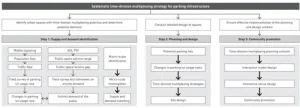
ELSE PRESS RELEASES FROM THIS DATE:
2024-07-23
The prevalence of kidney disease has been increasing in Japan, with it now affecting one in eight adults, but developing effective treatment remains a challenge. The kidneys are among the most energy-intensive organs in the body. For the kidneys to function, they constantly produce and consume large amounts of adenosine triphosphate (ATP), which is a chemical that the body uses to store and transport energy. However, ATP dynamics—the changes over time in ATP production and utilization—within the kidney have been poorly understood because of the lack of suitable imaging technologies.
Using a newly developed ATP imaging system, the researchers ...
2024-07-23
Guides typically assist tourists with directions, but the experience could be greatly enhanced if they offered personalized services tailored to individual interests. Recently, researchers have transformed guide RNAs, which direct enzymes, into a smart RNA capable of controlling networks in response to various signals. This innovative research is gaining significant attention in the academic community.
A research team consisting of Professor Jongmin Kim and PhD candidates Hansol Kang and Dongwon Park from the Department of Life Sciences at POSTECH has developed a multi-signal ...
2024-07-23
Volatile organic compounds (VOCs), with toxicity and irritability, could cause atmospheric environmental problems such as haze and photochemical smog, seriously threatening the ecological environment and human health. The primary source of VOCs is human production, such as the petrochemical industry, pharmaceutical industry, footwear industry, electronic manufacturing, and cooking fumes. Catalytic oxidation technology can highly effectively remove organic pollutants without secondary pollution, and it is receiving increasing attention in VOC pollution control. In real-world operating conditions, the ...
2024-07-23
HONG KONG (21 July 2024) --- The progress of solar energy technology took a step forward recently with the development of a groundbreaking living passivator at City University of Hong Kong (CityUHK) that can substantially enhance the stability and efficiency of perovskite solar cells.
This newly developed passivator is a type of corrosion inhibitor that appreciably changes the potential of a metal. The CityUHK technology leverages dynamic covalent bonds that activate on exposure to moisture and heat, enabling it to evolve new passivators in response to environmental factors.
This innovative approach allows for real-time repair and maintenance of perovskite solar cells. ...
2024-07-23
New research presented at this year’s Annual Meeting of the European Association for Study of Diabetes (Madrid, Spain, 9-13 September) shows that the risk of developing type 1 diabetes (T1D) decreases markedly in girls after age 10 years, while the risk in boys stays the same.
Furthermore, risk of T1D is significantly higher boys with a single autoantibody than their female counterparts, suggesting the sex could be linked with autoantibody development, indicating the importance of incorporating sex in the assessment ...
2024-07-22
Background and Goal: Sulfonylureas are a class of oral medications used to manage blood glucose levels in patients with type 2 diabetes. These drugs increase insulin production regardless of blood sugar levels. For this reason, the drugs can cause blood sugar to drop too low, leading to hypoglycemia. The goal of this study was to compare how prevalent impaired awareness of hypoglycemia was when patients with type 2 diabetes were treated with either insulin or sulfonylureas for both long and short-term periods.
Study Approach: Researchers collected data from a group of 898 participants with type 2 diabetes enrolled in pharmacies, clinics, ...
2024-07-22
Background and Goal: Social determinants of health are the conditions in which people are born, grow, live, work, and age. These conditions include income, education, and access to health care. Knowledge of these factors is essential for primary care clinicians to deliver fair and complete care, plan programs and distribute resources effectively. However, this information is rarely captured consistently in clinical settings. This study identified how an Artificial Intelligence (AI) social determinants of health tool can be designed using a collaborative design strategy with input from primary care team members.
Study Approach: ...
2024-07-22
Background and Goal: The COVID-19 pandemic likely worsened disparities in access to primary care. The goal of this study was to quantify the nationwide decline in primary care visits and the increase in telehealth utilization and explore whether certain groups of patients were disproportionately impacted.
Study Approach: Researchers used primary care electronic health record data from the American Family Cohort— to examine the percentage change in total visit volume, change in in-person visit volume, and telehealth ...
2024-07-22
Background and Goal: The Transforming Clinical Practice Initiative was a four-year nationwide program aimed at improving outpatient health care quality. The initiative, funded by the Centers for Medicare & Medicaid Services, also prepared practices for payment systems based on care quality rather than service quantity and included a Change Package to guide practice transformations. This research brief examines whether these transformations were associated with reductions in emergency department visits among both primary and specialty care practices.
Study Approach: Researchers analyzed data from 3,773 practices in the Transforming Clinical Practice ...
2024-07-22
Person-centered care focuses on treating patients as individuals with unique needs and involving them actively in their care decisions. The Person-Centered Primary Care Measure (PCPCM) is a recently developed, patient-reported survey able to assess person-centeredness. The PCPCM has demonstrated strong validity and reliability. The goal of this study was to translate the original PCPCM survey into Dutch, adapt the survey for people with low literacy, and evaluate its structure, consistency, and accuracy.
Study Approach: The survey was translated into Dutch and then back to English to ensure accuracy. The Dutch version was then tested to make sure it worked well for Dutch-speaking ...
LAST 30 PRESS RELEASES:
[Press-News.org] Time-division multiplexing planning and design strategies for parking lots in compact cities




